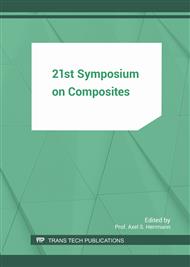p.473
p.482
p.490
p.498
p.506
p.512
p.520
p.527
p.535
One Step Production of Bicomponent Yarns with Glass Fibre Core and Thermoplastic Sheath for Composite Applications
Abstract:
The film stacking method is the industrial standard for the manufacturing of fibre reinforced thermoplastic composites (FRTCs). An alternative to this is commingling thermoplastic fibres with reinforcement fibres, e. g. glass fibres, into hybrid yarns. However, the composites produced by the use of film-stacking or hybrid yarns cannot achieve an optimal impregnation of reinforcement fibres with the matrix polymer. This stens from the high melt viscosity of thermoplastics, which prevents a uniform wetting of the reinforcement fibres. Leaving some fibers is unconnected to the matrix. This leads to composite lower strength than theoretically possible. The aim of the research is the coating of a single glass filament in the glass fibre nozzle drawing process to achive a homogenous distribution of glass fibres and matrix in the final composite. The approach uses particles with a diameter from 5 to 25 μm of polyamide 12 (PA 12) which are electrostatically charged and blown at an Eglass filament in the nozzle drawing process as seen in. The particles adhering to the filament are melted by infrared heating and winded afterwards. This development will allow the homogenous distribution of fibres and the matrix in a thermoplastic composite allowing a higher fibre volume content leading to improved mechanical properties. Even though the glass filaments could be coated with PA 12, a homogenous sheath could not be achieved in this investigation. Therefore, further research will focus on an improved homogeneity by reducing the agglomeration of PA 12, using dried PA12 and enhancing the coating setup.
Info:
Periodical:
Pages:
506-511
Citation:
Online since:
July 2017
Authors:
Price:
Сopyright:
© 2017 Trans Tech Publications Ltd. All Rights Reserved
Share:
Citation:


